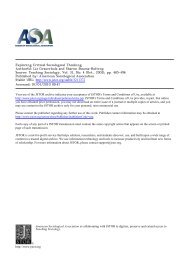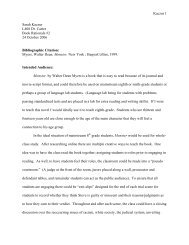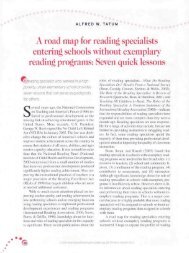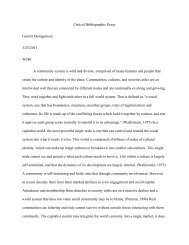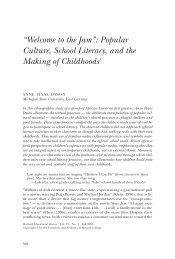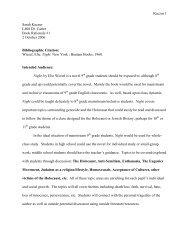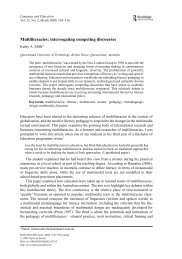Journal Writing in the Mathematics Classroom: A ... - Oncourse
Journal Writing in the Mathematics Classroom: A ... - Oncourse
Journal Writing in the Mathematics Classroom: A ... - Oncourse
You also want an ePaper? Increase the reach of your titles
YUMPU automatically turns print PDFs into web optimized ePapers that Google loves.
environment. Tasks that decl<strong>in</strong>ed <strong>in</strong> <strong>the</strong> level of cognitive demand, <strong>the</strong> tasks decl<strong>in</strong>ed <strong>in</strong>toprocedures without connection to mean<strong>in</strong>g, unsystematic exploration ornonma<strong>the</strong>matical activity.Ch. 1 and 2 of Pr<strong>in</strong>ciples and Standards for School Ma<strong>the</strong>matics by NCTMDecisions made by teachers, school adm<strong>in</strong>istrators and o<strong>the</strong>r education professionals about <strong>the</strong>content and character of school ma<strong>the</strong>matics have important consequences both for students andfor society. The Pr<strong>in</strong>ciples of equity, curriculum, teach<strong>in</strong>g, learn<strong>in</strong>g, assessment and technologyprovide guidance on describ<strong>in</strong>g particular features of high-quality ma<strong>the</strong>matics education.Ch. 8: Us<strong>in</strong>g Algebra Tiles to Multiply Monomials and B<strong>in</strong>omialsMonique’s goal for her students is that <strong>the</strong>y should understand <strong>the</strong> concepts underly<strong>in</strong>g <strong>the</strong>common algorithm for multiply monomials and b<strong>in</strong>omials. Monique wants her students to build<strong>the</strong>ir understand<strong>in</strong>g of algebraic operations us<strong>in</strong>g algebra tiles. However, she succumbs to <strong>the</strong>pressure of an upcom<strong>in</strong>g district test and tries to expedite <strong>the</strong> students’ learn<strong>in</strong>g process by firstshow<strong>in</strong>g <strong>the</strong>m a shortcut algorithm (FOIL) for multiply<strong>in</strong>g b<strong>in</strong>omials prior to <strong>the</strong>ir experienceswith <strong>the</strong> manipulatives. At <strong>the</strong> end of <strong>the</strong> lesson, Monique wonders whe<strong>the</strong>r <strong>the</strong> students weremak<strong>in</strong>g <strong>the</strong> connections she hoped <strong>the</strong>y would.Develop<strong>in</strong>g Understand<strong>in</strong>g through Problem Solv<strong>in</strong>g by James Hiebert and Diana WearneValu<strong>in</strong>g deep understand<strong>in</strong>g of ma<strong>the</strong>matics is an important goal for students. Problem solv<strong>in</strong>gleads to understand<strong>in</strong>g. Thus, one way to support students’ efforts to understand is to allowma<strong>the</strong>matics to be problematic for <strong>the</strong>m. Struggl<strong>in</strong>g, <strong>in</strong> a healthy sense and on <strong>the</strong> right k<strong>in</strong>ds ofproblems for an appropriate amount of time, prepares students to make sense of relevant<strong>in</strong>formation, to piece toge<strong>the</strong>r th<strong>in</strong>gs <strong>in</strong> new ways and to see <strong>the</strong> benefits of bettermethods of solution.Ma<strong>the</strong>matics as Sense Mak<strong>in</strong>g by Jeremy A. Kahan and Terrence R. WybergTeach<strong>in</strong>g math through problem solv<strong>in</strong>g beg<strong>in</strong>s by identify<strong>in</strong>g <strong>the</strong> important ma<strong>the</strong>matics that <strong>the</strong>students are to learn. We value students’ ma<strong>the</strong>matical understand<strong>in</strong>g result<strong>in</strong>g from teach<strong>in</strong>gthrough problem solv<strong>in</strong>g. By mak<strong>in</strong>g sense of and solv<strong>in</strong>g well-chosen problems with gentleguidance from an effective teacher, students encounter ma<strong>the</strong>matics, mak<strong>in</strong>g connections andma<strong>the</strong>matical th<strong>in</strong>k<strong>in</strong>g that are useful and important as well as rich and beautiful. F<strong>in</strong>ally,problems should be accessible and engag<strong>in</strong>g to students.The Sound of Problem Solv<strong>in</strong>g by Mark DriscollIn engag<strong>in</strong>g students as <strong>the</strong>y learn ma<strong>the</strong>matics through problem solv<strong>in</strong>g a teacher should listenwith <strong>the</strong> <strong>in</strong>tention of understand<strong>in</strong>g students’ th<strong>in</strong>k<strong>in</strong>g. In addition, this article suggests that <strong>the</strong>term student work should <strong>in</strong>clude what we hear as well as what we see. Arguably, goodma<strong>the</strong>matics teachers do all k<strong>in</strong>ds of listen<strong>in</strong>g at different times for different purposes. Questionscan help shape <strong>the</strong> k<strong>in</strong>ds of responses <strong>the</strong> teacher will hear and will help create a purpose forlisten<strong>in</strong>g. The impact of consistent, purposeful listen<strong>in</strong>g, especially <strong>in</strong> a problem-basedclassroom, can be a powerful way to elicit and understand students’ ma<strong>the</strong>matical th<strong>in</strong>k<strong>in</strong>g.



